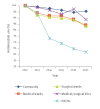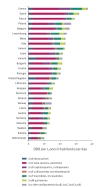Antimicrobial use trends, Israel, 2012 to 2017
- PMID: 31456558
- PMCID: PMC6712929
- DOI: 10.2807/1560-7917.ES.2019.24.34.1900022
Antimicrobial use trends, Israel, 2012 to 2017
Abstract
BackgroundIn 2012, Israel's National Center for Infection Control initiated a national stewardship programme that included mandatory annual reporting of antimicrobial use. Here we present nationwide Israeli data for the period 2012 to 2017.AimThe goal of this study was to detect trends in antimicrobial use in Israel following the introduction of the stewardship programme, as part of an assessment of the programme's impact.MethodsIn this retrospective observational study, data were collected from Israel's health maintenance organisations (HMOs), acute care hospitals and post-acute care hospitals (PACHs). Acute care hospital data were collected for general medical and surgical wards, and medical/surgical intensive care units (ICUs). Data were converted into defined daily doses (DDD), with use rates presented as DDD per 1,000 insured/day in the community and DDD per 100 patient-days in hospitals and PACHs. Trends were analysed using linear regression.ResultsAntimicrobial use decreased across sectors between 2012 and 2017. In the community, the decrease was modest, from 22.8 to 21.8 DDD per 1,000 insured per day (4.4%, p = 0.004). In acute care hospitals, antibiotic DDDs per 100 patient-days decreased from 100.0 to 84.0 (16.0%, p = 0.002) in medical wards, from 112.8 to 94.2 (16.5%, p = 0.004) in surgical wards and from 154.4 to 137.2 (11.1%, p = 0.04) in ICUs. Antimicrobial use decreased most markedly in PACHs, from 29.1 to 18.1 DDD per 100 patient-days (37.8%, p = 0.005).ConclusionBetween 2012 and 2017, antimicrobial use decreased significantly in all types of healthcare institutions in Israel, following the introduction of the nationwide antimicrobial stewardship programme.
Keywords: Israel; antibiotic; antimicrobial use; post-acute care hospital; stewardship; surveillance.
Conflict of interest statement
Figures





References
-
- European Centre for Disease Prevention and Control (ECDC). Antimicrobial consumption. In: ECDC. Annual epidemiological report 2017. Stockholm: ECDC; 2018. Available from: https://ecdc.europa.eu/sites/portal/files/documents/ESAC-NET-reportAER-2...
-
- European Centre for Disease Prevention and Control (ECDC). Summary of the latest data on antibiotic resistance in the European Union: EARS-Net surveillance data. Stockholm: ECDC; November 2017. Available from: https://ecdc.europa.eu/sites/portal/files/documents/EAAD%20EARS-Net%20su...
-
- Pan American Health Organization (PAHO). Informe anual de la red de monitoreo/vigilanciade la resistencia a los antibióticos y de infecciones asociadas a la atención de la salud – 2014. [Annual Report of the Network for Monitoring/Surveillance of Antibiotic Resistance and Health Care Associated Infections – 2014]. Goiânia: PAHO; 2014. [Accessed 15 Aug 2019]. Spanish. Available from: https://www.paho.org/hq/dmdocuments/2017/2014-cha-informe-anual-relavra.pdf
Publication types
MeSH terms
Substances
LinkOut - more resources
Full Text Sources
Medical
Research Materials
